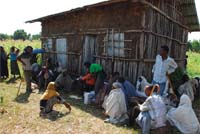Mobilising your community
There are important things that you need to bear in mind while mobilising your community. You need to encourage participation by as many community members as possible. This means working actively with the community to solve their own health-related problems. You really need to know your community.
Think about the community that you live or work in. Imagine a co-worker from another area is coming to join you. What do you want to say right at the beginning about your community? If you have not yet started to work as a Health Extension Practitioner think about the community in which you live.
Write the following information about your community below:
Name of your village/kebele__________________________
Languages they speak_______________________________
Festivals they celebrate ______________________________
Beliefs and values they have__________________________
Religion__________________________________________
Resources_________________________________________
Are there any particular health problems in the community?
Your answers will be individual to you and your community. The point of this question is that the more you know about the community (Figure 19.3), the more likely you will be to design health-related projects that fit the individual needs of that community.

However, knowing your community is only the beginning. Community mobilisation is an active process. Community participation is necessary at every step of the process, from identifying problems to solving the problems.
At the stage of identifying problems it is not good to say: 'I know what your problems are.' It is essential to encourage the community to identify their own problems first; then they will be more ready to deal with them. Secondly, get them participating in finding solutions. Communities have different amounts of resources, and they also have different values and beliefs. Things that work best for one person or one community may not work for another. So do not assume you know what the best solution is.
Be clear about what you can and should do, and also about what the community can and can't do. Always allow them to do some things for themselves. Together with the community, you should ask: 'What problems can we identify?', 'What are the best solutions we can select?', or 'What action can we take?' Following any community health activities, you should always get community members to participate in the evaluation. Discuss the results with the community, and in that way you can help them to learn. If they know why progress was achieved, or an action succeeded or failed, they will be able to make better efforts next time.
Now look back at the initial information you have set down about your community. You may have identified a health problem or problems. But is the community aware of these? If you asked them, would they also identify the same problem?
As a health worker, you may have noticed problems that are not seen by the community (for example, you may have data about infant mortality that confirm a higher than usual incidence). But is the community aware of this? Remember, as we have said, always begin by asking your community about problems — not telling them.